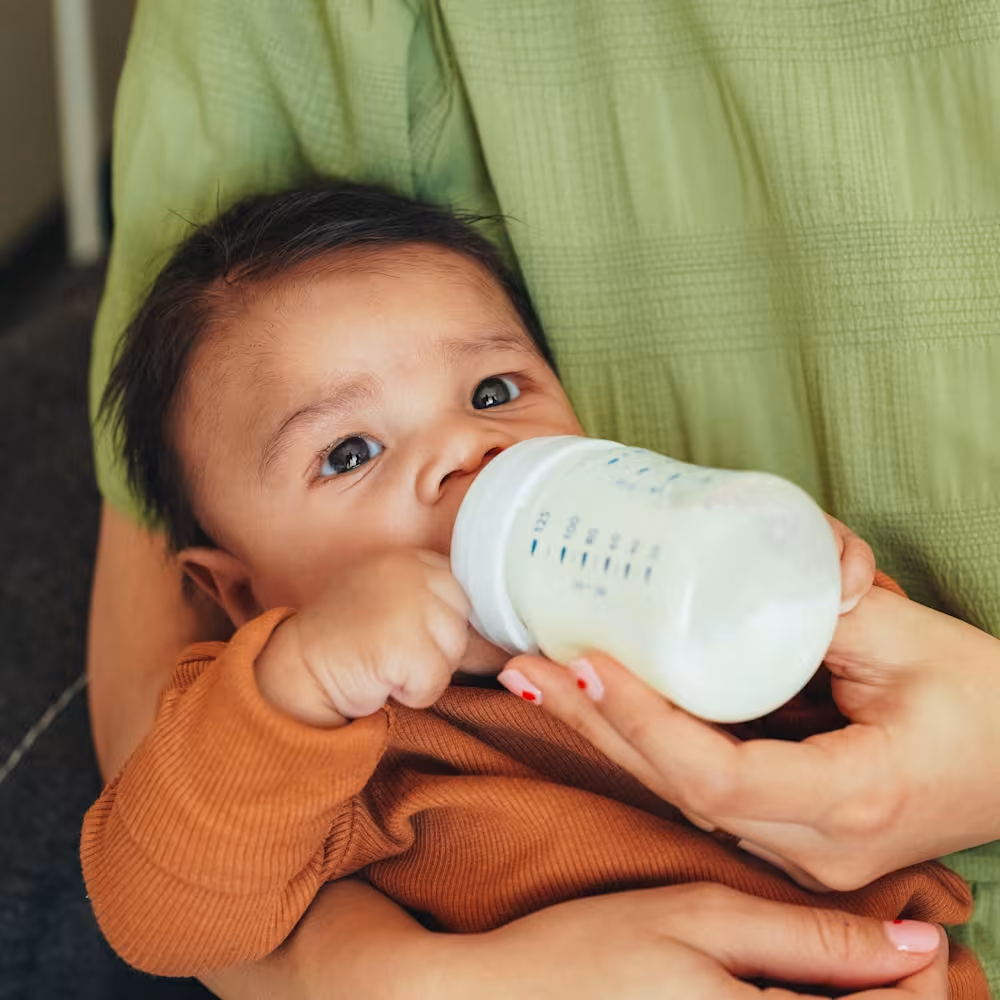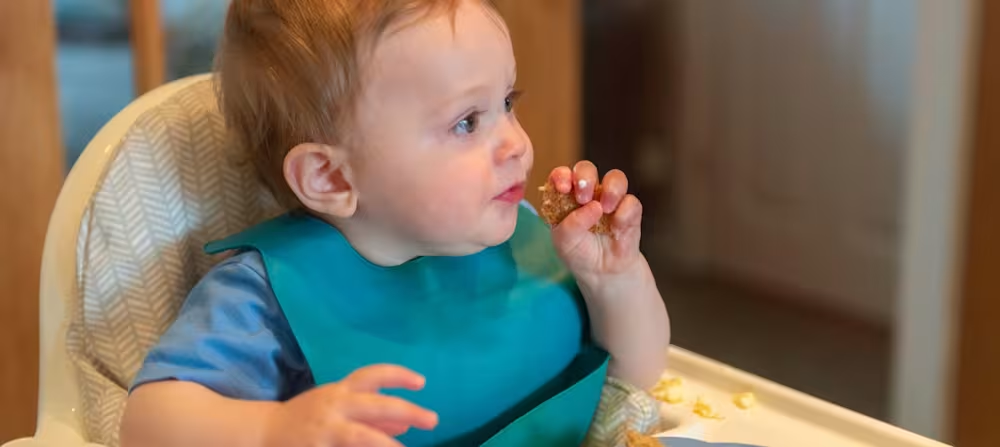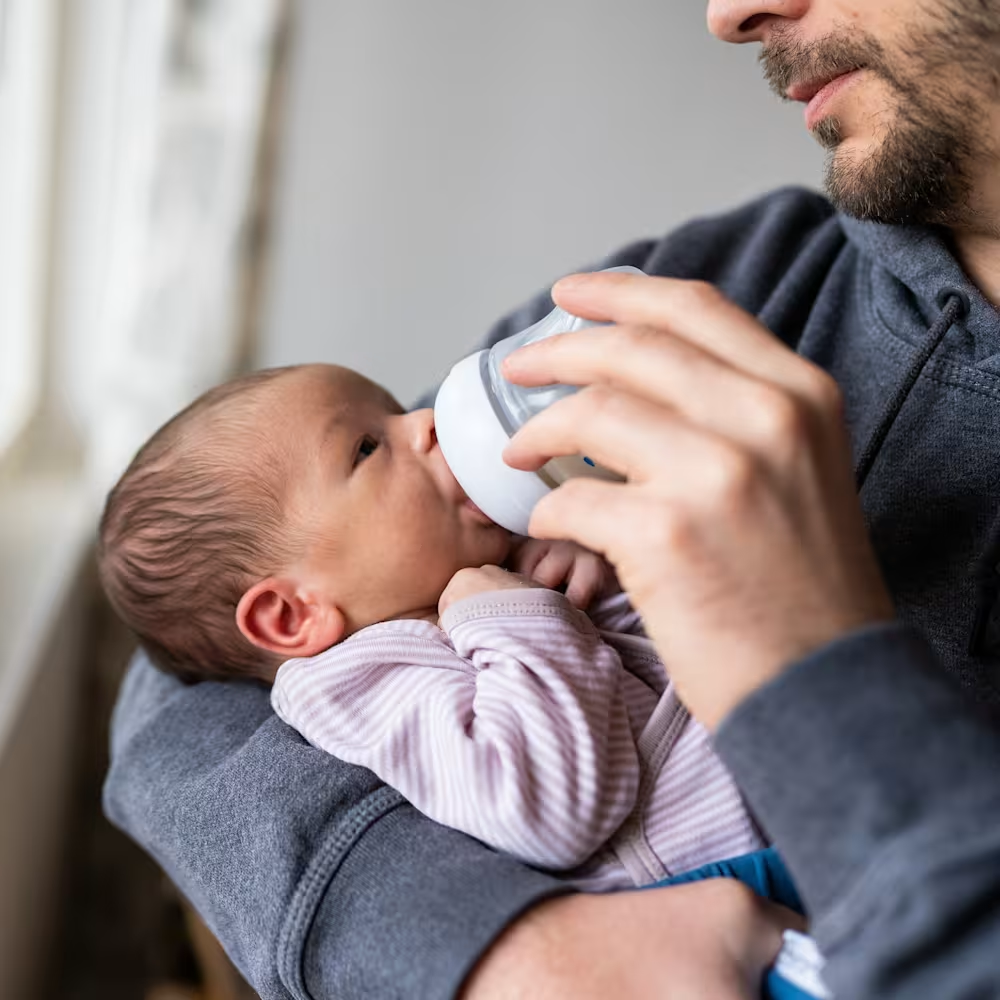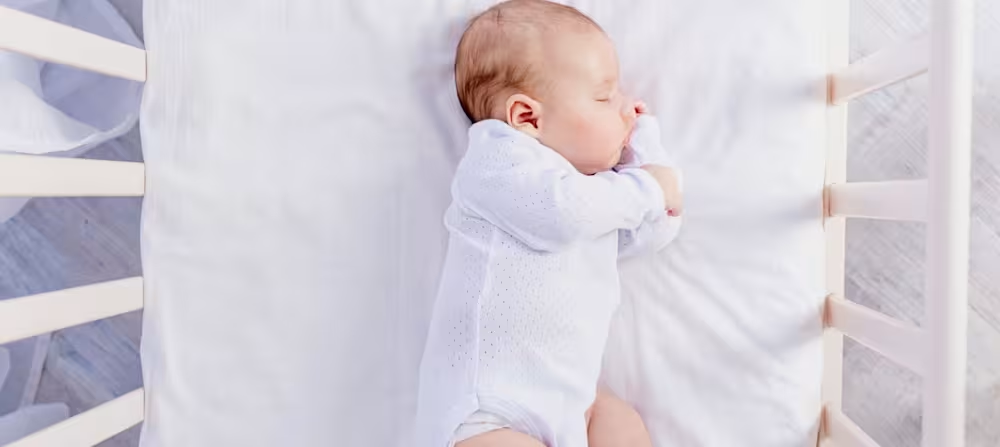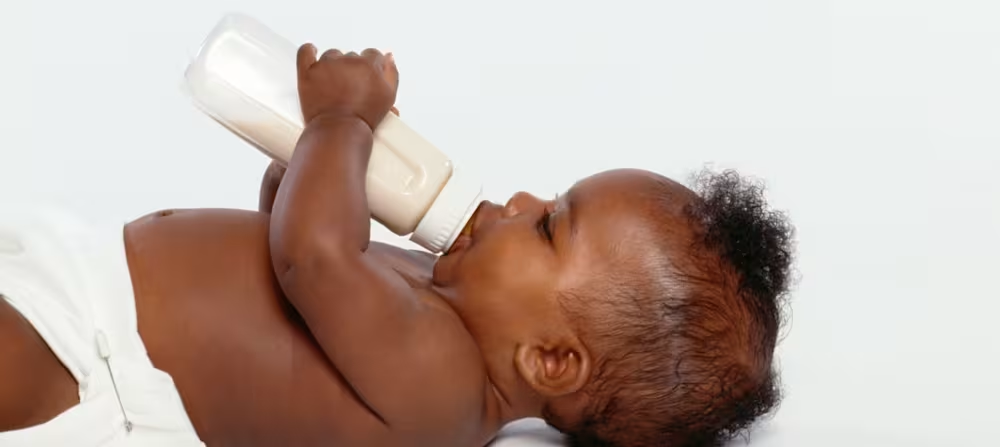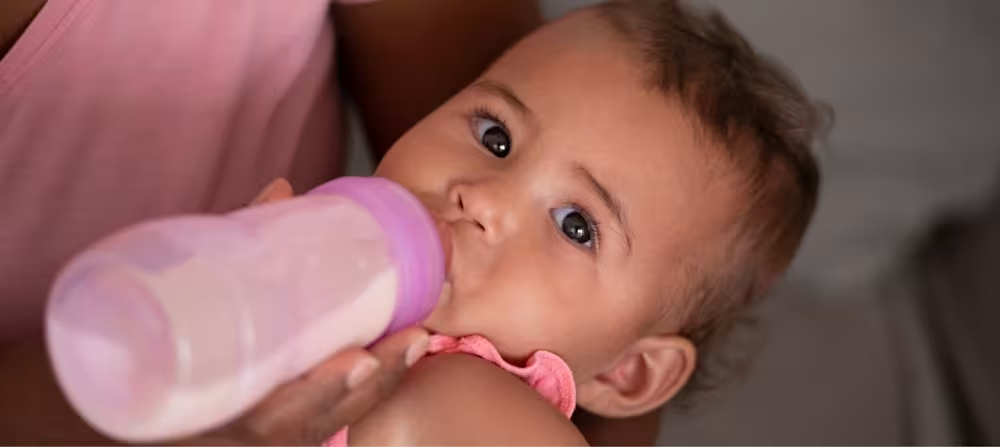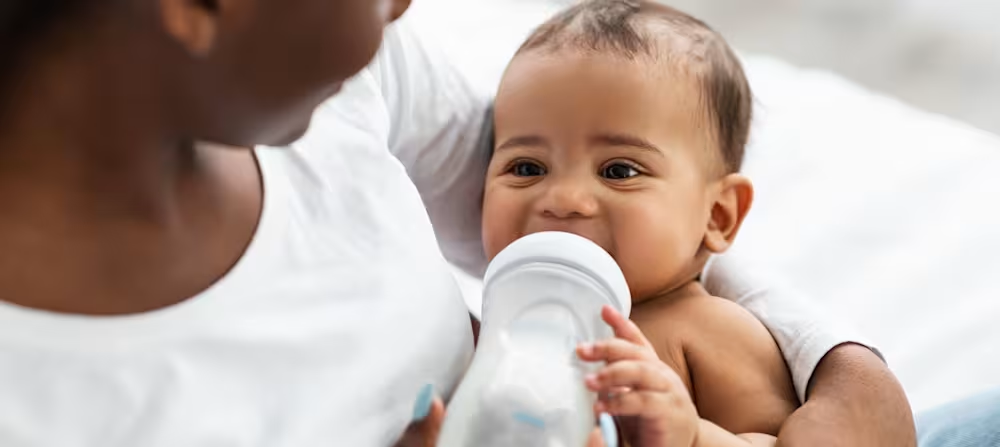Can you heat formula?
Updated Jan 02, 2026

Many families heat formula for their babies for a variety of reasons. Though heating formula isn’t required, many babies prefer it warm. If you decide to heat your baby’s formula, the most important thing is never to give them hot formula. Always check the temperature of the liquid on the inside of your wrist or the back of your hand before feeding it to your baby.
In this article, we’ll discuss ways to heat formula, provide step-by-step instructions for heating formula, and give you some safety tips.
What is formula?
Infant formula is food designed specifically for babies to meet their nutritional needs. You can use formula as a sole source of nutrition for your baby, or you can use it in combination with breast milk. If you’re wondering when to start transitioning away from formula, learn more about when babies .
Types of formula:
There are three main types of infant formula: powdered, liquid concentrate, and ready-to-feed. Which type you use may depend on your baby’s age and health, your budget, and your personal preference.
Powdered formula
Powdered formula typically comes in a can. You prepare it by combining it with water and shaking it. In general, most powdered formula uses one scoop of powder for every 2 ounces of water. However, some brands may vary, so follow specific instructions on the can you’re using.
When preparing powdered formula, always measure the water before adding the powder to ensure you use the correct ratio of powder to water. Powdered formula is typically the most budget-friendly option.
Liquid concentrate formula
Liquid concentrate formula is similar to powdered formula in that you add water, but to a liquid instead of a powder. Typically, you’ll add 1 ounce of water for every 1 ounce of concentrate, but follow the directions on the package to be sure. While liquid concentrate functions similarly to powdered formula, many parents find it easier to handle than powder. However, it tends to be a more expensive option.
Ready-to-feed formula
Ready-to-feed formula arrives ready to feed to your baby — no mixing required. It’s usually the most expensive option of the three formula types, so you’re paying for the convenience. It’s an easy option to have on hand in your diaper bag or for other situations where finding and measuring water might be difficult. Ready-to-feed formula is also generally recommended for premature babies or babies with health conditions. Ready-to-feed infant formula is the safest form of formula according to the FDA [].
Why would you heat baby formula?
You don’t have to heat formula. If your baby is content with drinking room temperature or cold formula, you don’t need to change anything. However, some caregivers decide to heat baby formula for the following reasons:
Reasons why parents heat formula
Baby’s preference
Some infants prefer warm formula, especially if they are used to drinking warm milk directly from the breast. They might protest and cry when given cold formula. Some babies might even spit up more or seem more uncomfortable when they drink cold formula.
Routine or habit
A warm bottle might be part of a baby’s routine, .
Personal preference
Some caregivers simply prefer to give their little one warm formula. They may find it to be more relaxing and comforting for their baby.
Methods for heating formula
There are a variety of safe warming methods for infant formula. Though you might use a microwave to heat many things in your home and it seems convenient, it is not recommended [] to heat infant formula in the microwave. This can create hot spots in the formula that could hurt your baby. Here are a few ways you can safely heat infant formula:
Warm water bath
For this method, you’ll put the prepared bottle into a bowl of warm water or hold it under running warm water at the sink, taking care not to get water on the bottle nipple as it may contaminate the formula [].
Bottle warmer
A baby bottle warmer makes warming simple, especially when you’re heating a bottle in the middle of the night. Most models only require putting the filled bottle in the warmer and turning it on. (Be sure to follow the manufacturer’s directions for your specific warmer.) Typically, it only takes a few minutes to warm a bottle with a bottle warmer.
Room temperature method
Some parents boil the water before mixing it with formula. If your baby is younger than 2 months old, was born prematurely, or has a weakened immune system, this is a beneficial practice that can kill harmful bacteria []. Once you mix the hot water with the formula, keep in mind you’ll need to let it sit at room temperature until it reaches a safe temperature for your baby to drink.
Step-by-step instructions for heating formula
To heat formula using the warm water bath method, follow these steps, as outlined by the CDC []:
After washing your hands, prepare your formula according to the instructions on the package.
Take care not to heat the formula to more than 100 degrees Fahrenheit. This can cause it to lose vitamins and nutrients []
If you have a cover or cap to go over the nipple, place that on the bottle. This helps prevent water from contaminating the bottle.
Hold the bottle under running warm water, or place it in a bowl of warm water.
After a few minutes, shake the bottle and put a few drops on the inside of your wrist. The formula should feel warm but not hot.
Tips for safely heating formula
When heating formula, follow safety guidelines to avoid contaminating the formula or accidentally burning your baby. Here are some safety precautions and formula-feeding tips to keep in mind:
Tip #1: Check temperature
Before feeding formula to your baby, check the temperature on yourself to avoid accidentally burning your baby. Shake the bottle first to ensure it’s warmed evenly, then place a few drops on the inside of your wrist or the back of your hand. Formula should feel warm, not hot, on your wrist.
Tip #2: Learn storage guidelines for heated formula
Understanding helps you keep your baby safe. Once you’ve prepared and heated your baby’s formula, use it within 2 hours. It’s not recommended to reheat formula after it’s been heated once. After you’ve fed your baby, throw away any formula left in the bottle. Once your baby’s mouth has touched the bottle, bacteria can grow, so it’s unsafe to keep it for another feeding.
Tip #3: Don’t put baby to bed with a bottle
It can be tempting to put your baby to bed with a bottle. However, giving your baby a bottle in bed can lead to tooth decay, and it’s associated with an increased risk of ear infections []. Babies are also prone to gagging and choking while lying on their back with a bottle, especially if they’re unsupervised.
Some parents choose to feed their baby to sleep, and that’s OK. A warm bottle can provide comfort for babies, and it’s part of the for many families. Just be sure to hold them upright and supervise them while they’re eating.
Note that for babies beyond the newborn stage, feeding to sleep can create an association that may make it harder for them to settle back down on their own at night []. Gradually introducing other soothing cues can help them learn to . This can help babies learn to fall back to sleep on their own during the night when they wake and aren’t hungry.
Tip #4: Consider extra safety precautions for some babies
Babies who are under 2 months old, were born prematurely, or have compromised immune systems are more susceptible to bacteria that could grow in their formula. If you’re mixing powdered formula, the ideal method is to mix it with very hot water. The CDC [] recommends boiling water and then waiting 5 minutes before mixing it with formula to kill any bacteria. Once it’s mixed, you’ll need to let it sit at room temperature to cool down before it’s safe for your baby to drink. Put a couple of drops on your wrist to test the temperature until it feels warm and not hot.
Tip #5: Don’t heat formula in the microwave
It’s not safe to heat infant formula in the microwave. Microwaves do not heat food evenly, which means you could end up with hot spots in the formula []. This could cause severe burns to your baby’s mouth and throat.
Takeaway
Many parents choose to heat infant formula because their baby prefers it, it’s comforting, and/or it’s part of their daily routine.
When feeding your baby, you can safely heat all 3 types of formula: powdered, liquid concentrate, and ready-to-feed. You can heat formula using warm water or with a bottle warmer. You can also boil water and mix it with formula after it has cooled for about 5 minutes.
Regardless of the method you choose, always take care not to give your baby hot formula. Shake the bottle then test a few drops on the inside of your wrist and give it to your baby when it feels warm, not hot. Never microwave baby formula, as this can cause it to develop hot spots that could burn your baby.
Heating formula FAQ
Share article:
Note: The content on this site is for informational purposes only and should not replace medical advice from your doctor, pediatrician, or medical professional. If you have questions or concerns, you should contact a medical professional.
